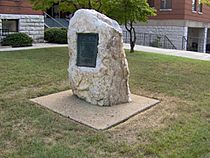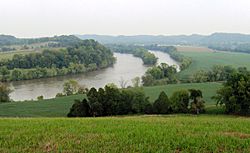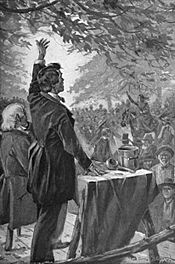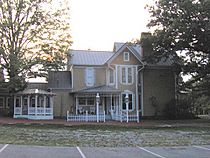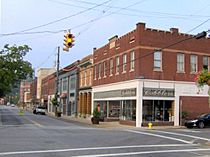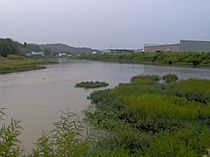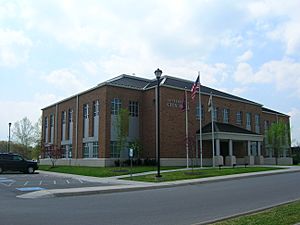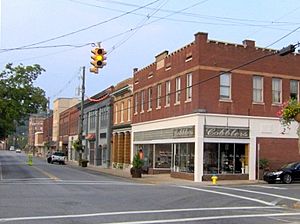Sevierville, Tennessee facts for kids
Quick facts for kids
Sevierville, Tennessee
|
|||
|---|---|---|---|
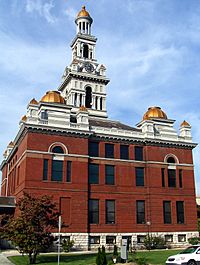
Sevier County Courthouse
|
|||
|
|||
| Motto(s):
"Your Hometown in the Smokies."
|
|||
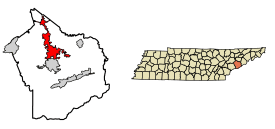
Location of Sevierville in Sevier County, Tennessee.
|
|||
| Country | United States | ||
| State | Tennessee | ||
| County | Sevier | ||
| Founded | 1795 | ||
| Incorporated | 1901 | ||
| Named for | John Sevier | ||
| Government | |||
| • Type | Mayor–council–administrator | ||
| Area | |||
| • Total | 24.25 sq mi (62.80 km2) | ||
| • Land | 24.12 sq mi (62.47 km2) | ||
| • Water | 0.13 sq mi (0.33 km2) 0.50% | ||
| Elevation | 971 ft (296 m) | ||
| Population
(2020)
|
|||
| • Total | 17,889 | ||
| • Density | 741.70/sq mi (286.37/km2) | ||
| Estimate | |||
| Time zone | UTC-5 (EST) | ||
| • Summer (DST) | UTC-4 (EDT) | ||
| ZIP Codes |
37764, 37862, 37864, 37876
|
||
| Area code(s) | 865 | ||
| FIPS code | 47-67120 | ||
| GNIS feature ID | 2405447 | ||
| Website | http://www.seviervilletn.org | ||
Sevierville (/səˈvɪərvɪl/ sə-VEER-vil) is a city in and the county seat of Sevier County, Tennessee, United States, located in eastern Tennessee. The population was 17,889 at the 2020 United States Census.
Contents
History
Native Americans of the Woodland period were among the first human inhabitants of what is now Sevierville, arriving sometime around 200 A.D. and living in villages scattered around the Forks-of-the-River area.
Between 1200 and 1500 A.D., during the Dallas Phase of the Mississippian period, a group of Native Americans established McMahan Mound Site, a relatively large village centered on a platform mound and village site surrounded by a palisade just above the confluence of the West Fork and the Little Pigeon River. This mound was approximately 16 feet (5 m) high and 240 feet (73 m) across. An excavation in 1881 unearthed burials, arrow-points, a marble pipe, glass beads, pottery, and engraved objects. At the time of this first excavation, the mound was located on a farm owned by the McMahan family, and was thus given the name "McMahan Indian Mound".
By the early 18th century, the Cherokee controlled much of the Tennessee side of the Smokies, establishing a series of settlements along the Little Tennessee River. A section of the Great Indian Warpath forked at the mouth of Boyd's Creek, just north of Sevierville. The main branch crossed the French Broad and continued along Dumplin Creek to the Nolichucky basin in northeastern Tennessee. The other branch, known as the Tuckaleechee and Southeastern Trail, turned south along the West Fork of the Little Pigeon River. This second branch forked again at modern-day Pigeon Forge, with the main trail turning east en route to Little River and the other branch, known as the Indian Gap Trail, crossing the crest of the Smokies to the south and descending into the Oconaluftee area of North Carolina. The various Cherokee trails criss-crossing Sevier Co. brought the first Euro-American traders and settlers to the area.
Early Euro-American settlement
European long hunters and traders arrived in the Sevierville area in the mid-18th century. Isaac Thomas (1735?-1818), the most notable of these early traders, was well respected by the Cherokee, and may have lived at the Overhill town of Chota at one time. Europeans like Thomas were mainly in search of animal furs, for which they exchanged manufactured goods.
As settlers began to trickle into East Tennessee, relations with the Cherokee began to turn hostile. During the Revolutionary War, the Cherokee, who had aligned themselves with the British, launched sporadic attacks against the sparse settlements in the Tennessee Valley. In December 1780, Col. John Sevier, fresh off a victory over the British at King's Mountain, launched a punitive expedition against the Cherokee. Sevier routed the Cherokee at the Battle of Boyd's Creek and proceeded to destroy several Cherokee settlements along the Little Tennessee.
A temporary truce secured by James White in 1783 led to an influx of Euro-American settlers in the French Broad valley. Hugh Henry (1756–1838) erected a small fort near the mouth of Dumplin Creek in 1782 known as Henry's Station. He was joined the following year by Samuel Newell (1754–1841), who established Newell's Station along Boyd's Creek, and Joshua Gist, who settled near the creek's mouth. Other early forts in the area included Willson's Station at the confluence of the East and Middle Fork of the Little Pigeon and Wear's Fort at the junction of the Southeastern and Tuckaleechee Trail and Indian Gap Trail. The Cherokee signed away all rights to what is now Sevier County in the 1785 Treaty of Dumplin, which was negotiated at Henry's Station.
In 1783, Isaac Thomas established a farm, trading post, and tavern at the confluence of the West Fork and the Little Pigeon River. He was joined shortly thereafter by Spencer Clack (1740–1832) and James McMahan, and a community known as "Forks of the Little Pigeon" developed around them. In 1789, Reverend Richard Wood (1756–1831) established Forks-of-the-River Baptist Church, which reported a congregation of 22 in 1790. By 1795, the congregation had 94 members.
Antebellum Sevierville
Sevier County was created in 1794 and named after John Sevier. At a meeting at Thomas's house the following year, the Forks-of-the-Little-Pigeon area was chosen as the county seat, and renamed "Sevierville." James McMahan donated a 25-acre (100,000 m2) tract upon which to erect a townsquare. This tract was parceled out into lots of 0.5 acres (2,000 m2) upon which the purchaser was required to build a brick, framed, or stone structure.
The first Sevier County Courthouse was built in 1796. Before its construction, according to local legend, court was held in a flea-infested abandoned stable. Irritated lawyers were said to have paid an unknown person a bottle of whiskey to burn down the stable, forcing the new county to build an actual courthouse.
As the county grew, several large farms were established in the fertile Boyd's Creek area. In 1792, Andrew Evans purchased a tract of land near the mouth of Boyd's Creek and built a ferry near the site of the old ford. In 1798, Evans sold the farm to John Brabson, and it was henceforth known as the Brabson's Ferry Plantation. In the early 1790s, Thomas Buckingham established a large farm between Boyd's Creek and Sevierville. Buckingham went on to become the county's first sheriff. In the early 19th century, Timothy Chandler and his son John Chandler (1786–1875) established the Wheatlands plantation in Boyds Creek.
As towns situated along the French Broad are connected via waterway to New Orleans, a flatboat trade flourished along the river in the early 19th century. In 1793, James Hubbert, who lived along Dumplin Creek, established Hubbert's Flat Landing to trade with flatboats moving up and down the river.
In the early 19th century, Knoxville and Asheville were connected via Route 17, a crude road which followed the banks of the French Broad. This new road gave Tennessee's cattle drovers greater access to markets along the east coast. In 1820, a stagecoach road connected Sevierville with Maryville to the west. Sevierville's situation as a county seat along these early roads helped it to grow. By 1833, the town had a population of 150, including two doctors, two carpenters, a tanner, two tailors, a shoemaker, three stores, a hatter, two taverns, and two mills. Distilleries were popular means of supplemental income. By 1850, John Chandler's distillery was producing 6,000 gallons of whiskey per year.
A notable late arrival in Sevierville was Dr. Robert H. Hodsden (1806–1864), who had been an attending physician for the Trail of Tears. In 1846, Hodsden began construction on a plantation near Fair Garden, just outside Sevierville to the east. This plantation, known as Rose Glen, was worth $28,000 in 1860, one of the most valuable in the county.
In 1856, a fire swept through Sevierville, burning a recently constructed courthouse, 41 houses, and several shops in the downtown area. The county lost nearly all of the vital records of its early settlers.
The Civil War
Slavery was not common in Sevier County, although there were instances, especially at the large plantations along the French Broad River. Even before the American Civil War, Sevierville, a hotbed of abolitionist activity, was home to a relatively large community of free African-Americans. In 1861, only 3.8% of Sevier Countians voted in favor of secession from the Union.
In late 1861, a pro-secession speech delivered by Henry Foote met with an angry response in Sevierville, and was followed by a series of explosive anti-secession speeches. The following year, pro-Union Knoxville newspaper editor Parson Brownlow gave a rousing anti-secession speech in Sevierville en route to a hideout in Wears Valley. Brownlow's audience remained gathered throughout the night after a rumor spread that Confederate forces were approaching. Union supporters in Sevier County were harassed and threatened throughout the war, even after Union forces under Ambrose Burnside occupied Knoxville in September 1863.
Sevierville, situated at a major crossroads south of Knoxville, suffered consistent harassment, looting, and confiscation of property by both Union and Confederate forces moving through the town in 1863 and 1864.
After Confederate General James Longstreet failed to retake Knoxville in the Battle of Fort Sanders, Union and Confederate forces quickly initiated a series of maneuvers to gain control of the strategic fords along the French Broad, culminating in an engagement near Hodsden's farm at Fair Garden in January 1864. Although the Union forces were victorious, they were later forced to retreat for lack of supplies. A state of general anarchy ensued, continuing until the end of the war.
At the war's end, the county's few remaining Confederate sympathizers, most notably members of the Brabson family, were forced to flee.
Postwar-present
Sevierville recovered quickly from the war, with a number of new houses and businesses being built in the 1870s. Two members of the town's African-American community — house builder Lewis Buckner (1856–1924) and brickmason Isaac Dockery (1832–1910) — would play a prominent role in Sevierville's post-war construction boom. Buckner designed a number of houses in the Sevierville area over a 40-year period, 15 of which still stand. Dockery's contributions include the New Salem Baptist Church in 1886 and the Sevier County Courthouse in 1896, both of which still stand.
By the 1880s, Sevierville was growing rapidly, as was the population of Sevier County. In 1887, the town had four general stores, two groceries, a jeweler, a sawmill, and two hotels. It was also home to the Sevierville Lumber Company, which had recently been established to harvest trees in the area. Tourists also started to trickle into Sevier County, drawn by the health-restoring qualities of mountain springs. Resorts sprang up throughout the county, with Seaton Springs and Henderson Springs located just south of Sevierville.
After a fire destroyed much of the downtown area in 1900, businesses shifted from the old town square at Main Street to the new Sevierville Commercial District, viz. Court Avenue and Bruce Street, which was centered on the new courthouse. The town incorporated in 1901.
In 1910, Indiana entrepreneur William J. Oliver finished work on the Knoxville, Sevierville and Eastern Railroad, which was Sevier County's first standard gauge rail line. Known as the Smoky Mountain Railroad, this line offered passenger service between Knoxville and Sevierville until 1962.
With the opening of the Great Smoky Mountains National Park in 1934, tens of thousands of tourists began passing through Sevierville, which was situated about halfway between the park and Knoxville. U.S. 441, initially known as the Smoky Mountain Highway, was completed to Sevierville in 1934, and later extended to North Carolina.
Entertainer Dolly Parton was born in Sevierville in 1946. Her ancestors had migrated to Greenbrier sometime around 1850, and later moved to Locust Ridge (near Pittman Center), where Parton was born, after the establishment of the national park. Parton has been honored with the Dolly Parton Parkway being named for her and with a statue on the lawn of the Sevierville courthouse.
Much of Cormac McCarthy's 1973 novel Child of God takes place in Sevierville and the surrounding area.
Geography
Sevierville is located at 35°52′39″N 83°34′12″W / 35.87750°N 83.57000°W (35.878, -83.570). In the town's eastern section, the Little Pigeon River is formed by the confluence of its East Fork and Middle Fork, both of which flow down from their sources high in the Great Smoky Mountains. Five miles (8 km) downstream to the west, the Little Pigeon absorbs its West Fork before turning north and flowing for another five miles (8 km) to its mouth along the French Broad River. Sevierville is centered on the stretch of land between these two junctions of the East and Middle Fork and the West Fork, known traditionally as Forks-of-the-Pigeon or Forks-of-the-River.
Situated in an area where the Foothills of the Great Smokies give way to the Tennessee Valley, Sevierville has long acted as a nexus between Knoxville to the north and the Appalachian towns in the mountains to the south. The Great Smoky Mountains National Park is located approximately ten miles south of Sevierville.
Due to its hilly terrain and the relatively poor roads of 19th-century Sevier County, a number of smaller communities developed independently along the outskirts of Sevierville. These include Harrisburg and Fair Garden to the east and Catlettsburg and Boyd's Creek to the north. In addition, the United States Postal Service associates the name "Sevierville" with ZIP codes for much of Sevier County, including the town of Pittman Center and other geographically extensive areas located outside Sevierville's city limits.
Several major state and federal highways intersect in Sevierville. U.S. Route 441, commonly called "The Parkway," connects Sevierville with Knoxville to the north and the national park and Cherokee, North Carolina to the south. The Sevierville section of U.S. 441 has been named "Forks-of-the-River Parkway." State Route 66, also called Winfield Dunn Parkway, connects Sevierville with Interstate 40 to the north. U.S. Route 411 traverses Sevierville from east to west, connecting Sevierville with Blount and Cocke counties. State Route 416 connects Sevierville with Pittman Center and U.S. Route 321 at the park boundary to the southeast.
According to the United States Census Bureau, the city has a total area of 20.0 square miles (52 km2), of which 19.9 square miles (52 km2) is land and 0.1 square miles (0.26 km2) (0.50%) is water.
Demographics
| Historical population | |||
|---|---|---|---|
| Census | Pop. | %± | |
| 1870 | 159 | — | |
| 1880 | 253 | 59.1% | |
| 1890 | 283 | 11.9% | |
| 1910 | 675 | — | |
| 1920 | 776 | 15.0% | |
| 1930 | 882 | 13.7% | |
| 1940 | 1,161 | 31.6% | |
| 1950 | 1,620 | 39.5% | |
| 1960 | 2,890 | 78.4% | |
| 1970 | 2,661 | −7.9% | |
| 1980 | 4,556 | 71.2% | |
| 1990 | 7,178 | 57.6% | |
| 2000 | 11,757 | 63.8% | |
| 2010 | 14,807 | 25.9% | |
| 2020 | 17,889 | 20.8% | |
| Sources: | |||
Sevierville is the principal city of the Sevierville, Tennessee, Micropolitan Statistical Area, which includes all of Sevier County, and is part of the Knoxville-Sevierville-La Follette Combined Statistical Area.
2020 census
| Race | Number | Percentage |
|---|---|---|
| White (non-Hispanic) | 13,017 | 72.77% |
| Black or African American (non-Hispanic) | 262 | 1.46% |
| Native American | 50 | 0.28% |
| Asian | 385 | 2.15% |
| Pacific Islander | 8 | 0.04% |
| Other/Mixed | 700 | 3.91% |
| Hispanic or Latino | 3,467 | 19.38% |
As of the 2020 United States census, there were 17,889 people, 6,026 households, and 3,949 families residing in the city.
2010 census
As of the 2010 United States Census, Sevierville had 14,807 people, 5,979 households, and 3,706 families residing in the city. The population density was 613.5 people per square mile (236.9/km2). There were 7,764 housing units at an average density of 321.7 per square mile (124.2/km2). The racial makeup of the city was 88.9% White, 1.5% African American, 0.6% Native American, 1.3% Asian, 0% Pacific Islander, 6.1% from other races, and 1.7% from two or more races. Hispanic or Latino of any race accounted for 10.3% of the population.
Of the 5,979 households, 29.9% had children under the age of 18 living with them, 43.1% were married couples living together, 13.6% had a female householder with no husband present, 5.3% had a male householder with no wife present, and 38% were non-families. 31.8% of all households were made up of individuals living alone, and 15% of those living alone were 65 years of age or older. The average household size was 2.35, and the average family size was 2.9.
The population consisted of 24.4% of individuals under the age of 20, 7.2% from 20 to 24, 26.5% from 25 to 44, 24% from 45 to 64, and 17.9% who were 65 years of age or older. The median age was 38.2 years. For every 100 females, there were 91.6 males. For every 100 females age 18 and over, there were 87.3 males.
According to 2012–2016 American Community Survey 5-Year Estimates conducted by the U.S. Census Bureau, the median income for a household in Sevierville was $37,784, and the median income for a family was $39,840. Males had a median income of $32,404 versus $29,172 for females. The per capita income for the city was $21,779. About 18.7% of families and 23.3% of the population were living below the poverty line, including 34.8% of those under age 18 and 8.7% of those age 65 or older.
Economy
Like other towns situated along the Parkway in Sevier County, Sevierville has reaped the benefits of the burgeoning tourism industry brought on by the development of Great Smoky Mountains National Park. As of 2004, nearly 50 percent of businesses based in Sevierville were linked to tourism. For example, there are more than 2,000 hotel and motel rooms in the city that generate more than $500,000 in hotel-motel tax revenues each year. There are a large number of cabins available as short term rentals in Sevierville.
In 2004, Sevierville established a Tourism Development Zone (TDZ) of 3 square miles (7.8 km2) to improve the central business district, funded by $150 million in bond sales between 2004 and 2008 (equivalent to $218 million in 2022). Sales tax revenues received from businesses in the TDZ are earmarked for bond payments, while property taxes are often rebated to help developers pay for their development projects in the TDZ.
East Tennessee Radio Group owns and operates the Sevierville area's primary local radio stations, WPFT-FM 106.3 and FM 105.5. Also, WWST-FM 102.1, a Top 40 music station serving the Knoxville market, is licensed by the Federal Communications Commission (FCC) to Sevierville.
Arts and culture
Annual cultural events
- Bloomin' Barbeque & Bluegrass Festival
- Dumplin Valley Bluegrass Festival
- Corvette Expo
- Sevier County Fair
- Shadrack's Christmas Wonderland
- Sevierville's Annual Christmas Parade
Tourism
- Burchfiel Grove Memorial Arboretum
- AdventureWorks Climb Zip Swing
- Forbidden Caverns
- Sevier Air Trampoline Park
- Douglas Dam
- Rainforest Adventures Discovery Zoo
- FoxFire Mountain Adventure Park
- Sevier County Heritage Museum
- Tennessee Museum of Aviation
- Scenic Helicopter Tours
- Tennessee Mountain Paintball
- NASCAR Speedpark
- Sky High Air Tours
- Tanger Outlets
- Smoky Mountain Knife Works & National Knife Museum
The following are located in the Kodak area of North Sevierville:
- Great Smokies Flea Market
- Smokies Stadium
Education
Sevierville is served by the Sevier County public school system. The educational system consists of the following public institutions:
- Elementary-Grammar level:
- Sevierville Primary School – Grades: Kindergarten-Second
- Sevierville Intermediate School – Grades: Third-Fifth
- T. Lawson Early Childhood – Grades: Pre-Kindergarten-Kindergarten
- Elementary-Grammar/Junior High level:
- Catons Chapel Elementary School – Grades: Kindergarten-Eighth
- New Center Elementary School – Grades: Kindergarten-Eighth
- Junior High level:
- Sevierville Middle School – Grades: Sixth-Eighth
- Junior High/Secondary level:
- Hardin Alternative Learning Center – Grades: Seventh-Twelfth
- Parkway Academy – Grades: Sixth-Twelfth
- Secondary level:
- Sevier County High School – Grades: Ninth-Twelfth
Sevierville is also home to the following private institutions:
- Elementary-Grammar level:
- Riverside Academy – Grades: Pre-Kindergarten-Fourth; Enrollment: 35
- Elementary-Grammar/Junior High/Secondary level:
- Covenant Christian Academy – Grades: Pre-Kindergarten-Twelfth; Enrollment: 450
- St. Andrew's School – Grades: Third-Twelfth; Enrollment: 26
- Ungraded:
- New Center Christian School – Enrollment: 11
In addition to the preceding institutions, Sevierville is home to the Sevier County satellite campus of Walters State Community College, based in Morristown, Tennessee. King University, based in Bristol, Tennessee, also operates a satellite campus in Sevierville at the Walters State Community College location.
Notable people
- Irene Bailey Baker (1901–1994): A former U.S. Representative for the 2nd District in Tennessee, Baker was born and raised in Sevierville.
- Reese Bowen Brabson (1817–1863): Brabson was a former member of the Tennessee House of Representatives and a U.S. Representative for Tennessee's 3rd district. Brabson's Ferry Plantation near Sevierville is on the National Register of Historic Places.
- Lewis Buckner (1856–1924): Enslaved before the Civil War, Buckner became a carpenter and furniture maker after abolition. Two of the homes he built in Sevierville in Sevier County – Riley H. Andes House and Trotter-Waters House – are on the National Register of Historic Places.
- Kristian Bush (1970–): Raised in Sevierville, Bush is one half of country duo Sugarland (with Jennifer Nettles) and the great-grandson of the founder of Bush Brothers and Company (the makers of Bush Beans).
- Bruce Connatser (1902–1971): Born in Sevierville, Connatser played first base for Major League Baseball's Cleveland Indians.
- Andrew E. Farmer (1979–): A current member (2018) of the Tennessee House of Representatives from the 17th district, Farmer is a resident of Sevierville.
- Robert H. Hodsden (1806–1864): A planter and doctor who provided medical care along the Trail of Tears, Hodsden served as President of the East Tennessee Medical Society and spent several terms in the Tennessee House of Representatives. His former home near Sevierville, Rose Glen, is on the National Register of Historic Places.
- Jason Layman (1973–): Born and raised in Sevierville, Layman played college football for the Tennessee Volunteers and was drafted as an offensive lineman for the Houston Oilers in the National Football League.
- Roy Hardee "Red" Massey (1890–1954): A Major League Baseball player who played one season for the Boston Braves, Massey was born in Sevierville.
- Zachary D. Massey (1864–1923): Throughout his life, Massey served as a U.S. Representative for Tennessee's 1st district, a senator in the Tennessee Senate, and postmaster of Sevierville.
- The McCarters: The vocal country music trio consisting of Jennifer, Lisa, and Teresa McCarter grew up in Sevierville.
- John Porter McCown (1815–1879): Born near Sevierville, McCown was a career soldier in the U.S. Army who resigned to join the Confederate Army during the American Civil War. He also fought in the Seminole Wars and the Mexican-American War.
- Richard Montgomery (1946–): A former member of the Tennessee House of Representatives from the 12th district, Montgomery was born in Sevierville and served on the Sevier County Board of Education for 16 years.
- Dolly Parton (1946–): Country music star Dolly Parton has composed more than 3,000 songs throughout her career and was inducted into the Country Music Hall of Fame. Sevierville is her home town.
- Randy Parton (1953–2021): The younger brother of Dolly Parton, Randy was a country singer, songwriter, and actor.
- Stella Parton (1949–): The younger sister of Dolly Parton, Stella is also a country singer and songwriter.
- Cecil T. Patterson (1930–2002): Born in Sevierville, Patterson introduced the Wadō-ryū style of karate into the Eastern United States in 1958 and later established the United States Eastern Wadō-ryū Federation.
- Isaac Thomas (1784–1859): An early U.S. Representative for Tennessee's 3rd district, Thomas was born in Sevierville.
- Gary R. Wade: A former mayor of Sevierville (1977–1987), Wade also served on the Tennessee Court of Criminal Appeals and the Tennessee Supreme Court.
- Ella Mae Wiggins (correct spelling May)(1900–1929): A ballad writer and union organizer for the National Textile Workers Union, Wiggins was murdered during the Loray Mill Strike in North Carolina. She was born in Sevierville.
See also
 In Spanish: Sevierville (Tennessee) para niños
In Spanish: Sevierville (Tennessee) para niños







